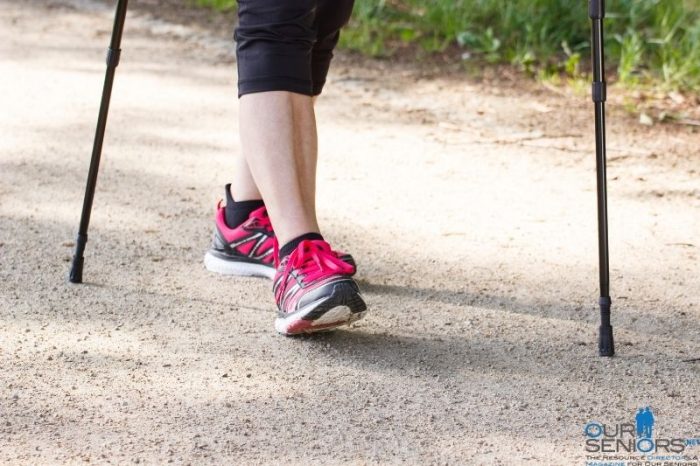Walking is a highly beneficial activity for people of all ages, seniors included. The National Institute on Aging specifically recommends walking as an exercise for seniors because it is relatively low impact, unlikely to produce injury, and its intensity level can be raised at the senior’s own pace.
The benefits of walking are too great to ignore. Even so, there is one caution about that “special equipment” feature – a walker needs good shoes, fitted to his or her special requirements. Seniors are more likely to have these special requirements because foot problems become more common as we age. The normal wear on feet through the years inevitably produces changes. Feet tend to become wider, and the fatty pads that cushion the bottoms of feet become thin or disappear. Seniors should have their feet measured more often than younger people, not assuming that their shoe sizes remain unchanged.
Shoes are a part of a person’s wardrobe, but they are also functional items that can directly affect your physical wellbeing. For that reason, seniors should pay more attention when buying shoes than they pay to other clothing items. It is a good idea to have a pair of shoes intended just for use during exercise walking. Choosing the best walking shoe is more complicated than it first seems, and you may need the advice of a professional. If you go to a podiatrist or foot specialist, they will have information about local merchants who can meet your special needs.
If you do not have a foot specialist, do a Google search for something like, “Walking shoes near me.” If you live in an urban or suburban area, this will most likely direct you to stores that still fit shoes to customers. Here are some tips for those who are going to a retail store:
- If possible, go to an athletic shoe or specialist shoe store. You will find the most options there.
- Wear the socks you plan to wear while walking. The thickness of sock material can make a difference.
- Try to shop for shoes later in the day. Your feet get somewhat larger after standing and walking for a while.
- Take foot measurements while standing. Your feet expand when you are upright, as you must be when walking.
- Take shoe measurements for both feet. Do not assume that both feet are the same; conditions like vascular changes and bunions can cause significant differences. If one foot is larger than the other, try on a pair that fits your larger foot.
- With both shoes on, wiggle your toes to see if you have adequate space. There should be enough space to freely move all of your toes.
- Buy shoes that conform to these sizes, not what you remember from the past. Do not buy shoes that seem too tight when you first try them on. Shoes do stretch, but you cannot count on this to conform to your foot size.
- Walk at least a short distance in both shoes before buying. Properly fitted shoes should feel comfortable right away.
If you have no foot problems and feel comfortable buying shoes “off the rack” or online, you should still look for some important features in good walking shoes. The Achilles tendon protector is the raised structure at the back of the shoe. It reduces strain on the Achilles tendon by firmly holding the shoe around the heel. The heel collar is the thickened area around the back of the shoe; it functions to cushion the ankle and heel. The “upper” is the part of the shoe that holds it on the foot. You may want to compare leather, mesh or synthetic uppers. The insoles are the inside floor of the shoe. Insoles may have the most noticeable effect on comfort. They cushion and support the foot and arch. Some shoes may have removable insoles that can be taken out for cleaning or replacement.
The shoes alone may not provide the ideal support needed. Because each foot may be different, each shoe may require modifications for the feet to feel balanced within the walking shoes. Removable shoe inserts (orthotics) may be placed within the shoes to correct these differences. These may replace or sit on top of the existing insoles. They can be prefabricated or prescription items, and custom-fit orthotics may be available via “foot mapping” in local stores. Some chain stores (i.e., CVS, Rite-Aid and Walmart) have computerized kiosks that analyze foot patterns and recommend specific inserts.
The outsole (bottom) of the shoe is where the “rubber meets the road.” The treads or grooves in the outsole may make some difference, especially if you walk on natural surfaces or trails. Quality shoes may continue to look good for years, but experts recommend regular replacements after about 300 to 400 miles of walking. Most shoes lose their impact protection after this length of use, so keep a record of miles traveled and replace shoes just as you would automobile tires.
Seniors are more likely to suffer from medical problems like diabetes and arthritis that can affect foot health. Medical professionals can provide advice about footwear for these special needs. Hopefully, these conditions will not exclude the very healthful activity of walking.

